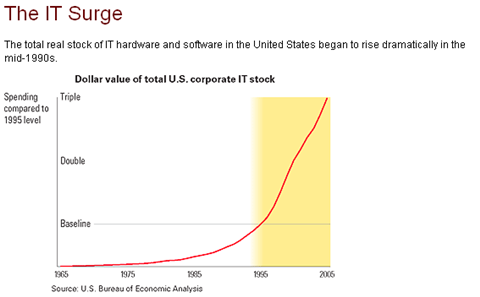Enterprise IT and the hypercompetition boom

Corporate information technology has led to more winner take all markets and a super competitive business environment where players often flame out as quickly as they showed up.
That's the big conclusion from Andrew McAfee and Erik Brynjolfsson in this month's Harvard Business Review.
Among the key points:
- In the mid-1990s investments in enterprise IT marked "a clear discontinuity in competitive dynamics" because technology investment went mainstream. In other words, all industries and companies invested in supply chain management, enterprise resource planning and other systems. Corporate IT investment went from $3,500 per worker in 1994 to $8,000 in 2005, according to the Bureau of Economic Analysis (chart via HBR).
- This IT investment widened the gap between leaders and laggards. More industries are winner take all sectors now--even traditional markets.
- Focus on the processes not the products. The number of digital products hasn't ballooned, but processes have. Digital processes allowed companies in traditional industries to replicate operational efficiencies. These efficiencies are the hammer leaders use to beat laggards with.
- Managers need to be creative with business processes and use IT to enable them.
None of those takeaways are all that surprising, but the Harvard Business Review article does hit at a key point. Business is becoming a zero sum game and corporate IT made it that way. Disruption and turbulence are the norm. Companies like Google can come from out of the blue and be a near search monopoly.
McAfee and Brynjolfsson controlled for other factors to isolate IT spending. Overall, it's clear that getting IT right is critical to corporate performance (see HBR's chart).
In theory, this competition should continue as companies pursue process innovation and digital improvements. Digital processes that make an impact apply across an entire company, produce results immediately, are precise, consistent, easy to monitor and enforceable.
The rub: All of this corporate technology innovation is easier said than done. Reading the research of McAfee and Brynjolfsson you have a few "of course" moments where the advice sounds obvious. Of course, IT has increased competition. Of course, business is almost zero sum. Of course, enterprise technology is the big difference between leaders and laggards.
But corporations fumble enterprise technology all the time. We have a blog devoted to IT failures. It's not the most optimistic blog you'll find, but it does reflect reality. That's why there are so few leaders and a lot of laggards. Many CIOs are mired in a rat's nest of legacy systems, increasing demands and endless talk about business alignment. The big question is how do you get out of that muck to actually innovate to become a big winner.
